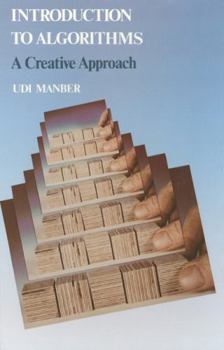Introduction to Algorithms: A Creative Approach
Select Format
Select Condition 
Book Overview
This book emphasizes the creative aspects of algorithm design by examining steps used in the process of algorithms development. The heart of this creative process lies in an analogy between proving... This description may be from another edition of this product.
Format:Paperback
Language:English
ISBN:0201120372
ISBN13:9780201120370
Release Date:January 1989
Publisher:Pearson
Length:478 Pages
Weight:1.78 lbs.
Dimensions:1.0" x 6.6" x 9.6"
Customer Reviews
5 ratings
a *creative* approach
Published by Thriftbooks.com User , 16 years ago
This book is much more than a catalog of algorithms (e.g., CLR): its purpose is to train your intuition to recognize mathematical structure in abstract problems. What does it matter if you know Dijkstra's algorithm? It's much more valuable to have good intuitions and a inductive reasoning tool chest with which to smash apart all of the variations of the shortest path problem (for example.) The reviewers who wrote that the book "assumes you are a math wiz" and that it provides "little or no guidance for solving an arbitrary problem of the same type" didn't get it. This book is trying very hard to make you into a wiz by forcing you to really interact with mathematics, rather than working through a set of nearly identical problems (--what passes for "education" in North America.) I was just going to leave my review at that, but since the reviews that people find "helpful" are so way off base, I think I should throw in a relevant story. When my friend was in grade 11, he showed up to the Canadian Computing Competition finals, placing 14th. The guy who won told him, "if you want to win, read this book." Two years later, he won the CCC against 2000 other students. This book is the best introduction you can give a budding mathematician. Sure: you can cough up what you've memorized from CLR during your university algorithms course. But, do you want to learn to invent algorithms yourself? Math is not something handed down generations in big, dry, textbooks. Like all knowledge, math is organically discovered Truth, and you have learn to discover it for yourself.
Complementary to the CLR.
Published by Thriftbooks.com User , 17 years ago
I wonder why this book is not as popular as it should be. Although the CLR is the mandatory book of most introduction to algorithm classes, it does not say much of how they came up with those algorithms which is the role of this book. The unique interesting thing is it uses induction to explain how each algorithm was developed, however I guess it's not the primary objective of the author. He wanted readers to read the description of the problems that those algorithms try to solve, and learn to apply induction to solve them on their own. If you like solving puzzle, you will love it.
Great on algorithm design, not that good on analysis
Published by Thriftbooks.com User , 20 years ago
I like this book a lot. I think it's a good reference and introductory text, maybe as a supplement. It's much easier to read than Cormen's, but not half as deep. Pros: - Easy to read. You can understand an algorithm much faster if you go to this book first. - Good examples and pictures. - Explain the ideas that lead to efficient algorithmic designs. Cons: - Doesn't go into enough details about the proofs of correctness and complexity. - The approach is different than most books and may take some time to get used to.
fantastic
Published by Thriftbooks.com User , 21 years ago
It's a very perfect book to become familiar with mainmethods of producing effective algorithms.
Excellent supplemental book
Published by Thriftbooks.com User , 24 years ago
This book is a great supplement and not a bad introduction book either. If you find that you still have holes in your knowledge after reading the Cormen book (as I did) you'll find that many of them can be filled with this book. This book also has a better chapter on NP Complete problems than the Cormen book.






